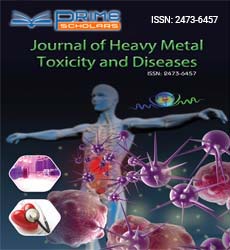Commentary - (2023) Volume 8, Issue 6
Unraveling the Complexities: Exploring Methods of Heavy Metal Analysis
Zha Sha*
Department of Environmental Science, Huaqiao University, China
*Correspondence:
Zha Sha,
Department of Environmental Science, Huaqiao University,
China,
Email:
Received: 29-Nov-2023, Manuscript No. ipjhmct-24-18980;
Editor assigned: 01-Dec-2023, Pre QC No. ipjhmct-24-18980 (PQ);
Reviewed: 15-Dec-2023, QC No. ipjhmct-24-18980;
Revised: 20-Dec-2023, Manuscript No. ipjhmct-24-18980 (R);
Published:
27-Dec-2023, DOI: 10.21767/2473-6457.23.6.58
Description
Heavy metals, owing to their persistence and potential toxicity,
pose significant threats to environmental and human health.
Accurate and reliable methods of heavy metal analysis are
crucial for monitoring and mitigating their impact. This article
delves into various techniques employed in heavy metal analysis,
highlighting the strengths and limitations of each method.
Atomic Absorption Spectroscopy is a widely used technique
for quantifying the concentration of individual heavy metals in
a sample. It relies on the absorption of specific wavelengths of
light by atoms in the vapor phase. AAS offers high sensitivity and
selectivity, making it suitable for trace metal analysis. However,
it may require complex sample preparation and lacks the ability
to simultaneously analyze multiple metals. ICP-MS is a powerful
analytical technique that combines inductively coupled plasma
with mass spectrometry. It can detect a broad range of heavy
metals at extremely low concentrations. ICP-MS is known for
its high sensitivity, precision, and ability to analyze multiple
elements simultaneously. However, the equipment is expensive,
and skilled operators are required for accurate results. XRF is a
non-destructive technique that measures the fluorescent X-rays
emitted by a sample when exposed to X-rays. It is commonly
used for elemental analysis in a variety of materials, including
soils, sediments, and metals. XRF offers rapid analysis but
may have limitations in detecting low concentrations and
differentiating between elemental forms. Voltammetry involves
measuring the current as a function of applied potential in an
electrochemical cell. Different types of voltammetry, such
as stripping voltammetry and polarography, are employed
for heavy metal analysis. Voltammetric methods offer high
sensitivity, low detection limits, and the ability to analyze metals
in complex matrices. However, they may require careful control
of experimental conditions. Ion chromatography is a separation
technique based on the differential migration of ions through a
chromatographic column. It is particularly useful for analyzing
ionic species, including various heavy metal ions. IC is known for
its versatility, allowing for the simultaneous analysis of multiple
ions. However, it may have limitations in terms of sensitivity
compared to other techniques. FAES involves measuring the
intensity of light emitted by excited atoms in a flame. It is suitable
for the analysis of certain metals, such as alkali and alkaline earth
metals. FAES is relatively simple, cost-effective, and provides rapid
results. However, it may face challenges with complex sample
matrices. While traditionally associated with medical imaging,
MRI has found applications in heavy metal analysis, especially in
geological and environmental studies. Solid-state NMR (Nuclear
Magnetic Resonance) provides insights into the speciation and
distribution of heavy metals in solid samples. MRI offers nondestructive
imaging capabilities, allowing for spatial visualization
of metal distribution. Colorimetric and gravimetric methods are
classical techniques for heavy metal analysis. Colorimetry relies
on the measurement of color changes in the presence of specific
metals, while gravimetry involves the determination of mass
changes. These methods are simple, cost-effective, and can be
applied to a wide range of sample types. However, they may lack
the precision and sensitivity of modern instrumental techniques.
The selection of a suitable method for heavy metal analysis
depends on various factors, including the type of sample, the
concentration range of the metals of interest, and the required
sensitivity. Often, a combination of techniques is employed to
cross-verify results and ensure accuracy. As technology continues
to advance, the field of heavy metal analysis evolves, offering
researchers a diverse toolkit to unravel the complexities of metal
contamination in our environment. These analytical methods
play a pivotal role in environmental monitoring, regulatory
compliance, and ultimately, safeguarding ecosystems and human
health from the detrimental effects of heavy metal exposure.
Acknowledgement
None.
Conflict Of Interest
The author states there is no conflict of interest.
Citation: Sha Z (2023) Unraveling the Complexities: Exploring Methods of Heavy Metal Analysis. J Heavy Met Toxicity Dis. 08:58.
Copyright: © 2023 Sha Z. This is an open-access article distributed under the terms of the Creative Commons Attribution License, which permits unrestricted use, distribution, and reproduction in any medium, provided the original author and source are credited.

